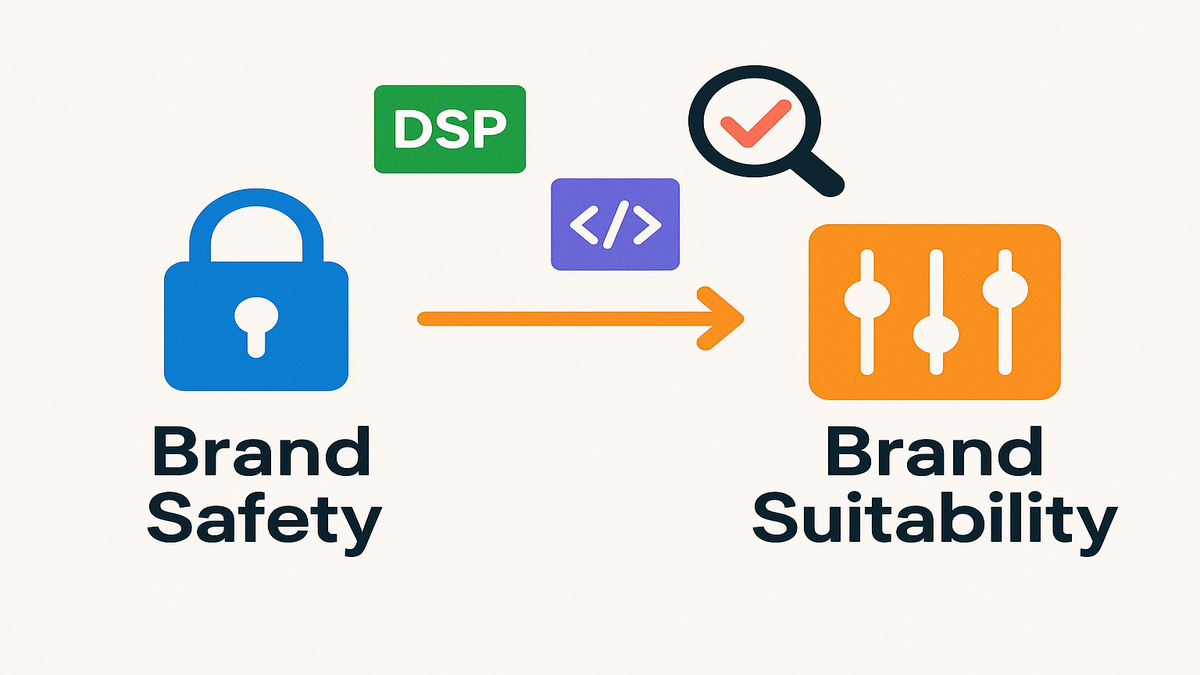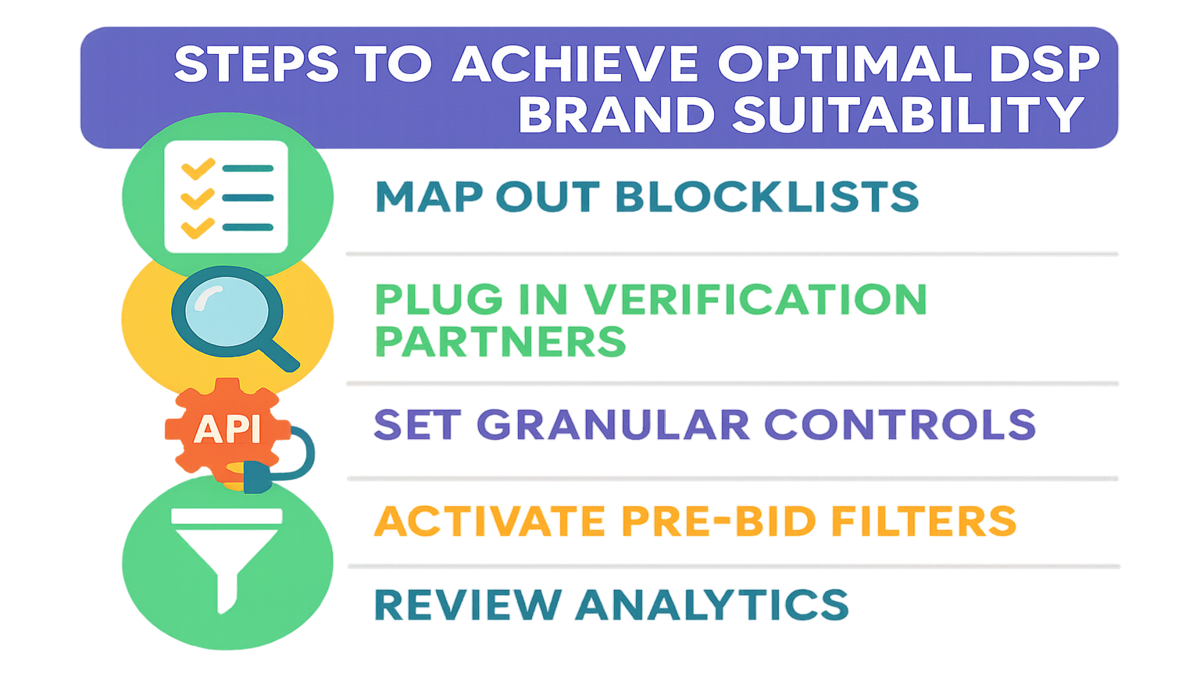
Unlock Real Brand Safety With DSP Suitability Settings

You’re dumping money into digital ads, but guess what? One dumb media placement and boom—your brand’s in trouble. Doesn’t matter if your campaign’s perfect. All it takes is one scandal. These days, a single screenshot can go viral for all the wrong reasons.
That nerves you out? Yeah, you’re not alone. Doesn’t matter if you’re hustling as a tiny startup or running a Fortune 500 empire. You need more than wishful thinking. A crusty old keyword blocklist won’t save you. Every ad impression could end up in the headlines. And look, people have no patience for brands who don’t track where their ads land. When someone calls you out, “Did you really mean to show up next to that crazy conspiracy theory?”—you want to say, “Nope, and here’s the data to prove it.”
That’s where new, souped-up DSP brand suitability settings step in. Forget the usual keyword blocklists or that silly check-the-box stuff. This is big—API controls, smart pre-bid checks, and easy plug-in partners kicking out the risky stuff before money even leaves your wallet.
If you run digital ads (especially through test runs like Adobe DSP open beta), this is for you. Your brand sounds like you want, ads work better, and hey, you might even sleep better. Stick around to see why brand suitability matters, how top platforms are stepping it up, and how you can get more control. It’s not just about avoiding drama. It’s about smarter spending, real trust, and leveling up your campaign skills.
Skip brand suitability, and you’re speeding in a Lambo with no insurance. Fun—until you crash.
Key Takeaways
- Some DSPs now let you control brand suitability at the advertiser or ad-group level with APIs.
- Real brand safety means matching ads to brand vibe, not just avoiding scandals.
- Plug-ins like DoubleVerify, IAS, Comscore, and Peer39 keep checks tight and automatic.
- Pre-bid and post-bid controls block problems before you get burned.
- Reports let you tweak your strategy for safety and audience match.

Brand Suitability and DSPs
Before, advertising was simple: show up where your customers hang out, and avoid the sketchy places. Safety meant one big no-go list—sites flagged for bad content, hate, or scammy clickbait. But times changed. Dodging trouble doesn’t win you trust anymore.
Sure, avoiding hate and clickbait is good. But what about tone? Or just the plain mood of a page? That’s where brand suitability beats old brand safety. Like, if you’re selling a fun soda, your ad shouldn’t sit next to sob stories about Wall Street. Nothing illegal there, but the vibe is all wrong. Suitability settings let you find your perfect spot and skip the off-brand stuff, not just monsters and messes.
Pratiti Raychoudhury, once Meta’s Head of Research, even joked, “Reputation takes years, but it can blow up in seconds.” Today’s risks aren’t just PR’s headache. Mess up, and your results tank. A 2023 GumGum survey said 68% of buyers lost trust if an ad landed on some sketchy or gross content. Trust equals cash, and a lousy placement can ruin your whole campaign’s payout.
Context and Nuance in Suitability
It’s not just about blocking junk—it’s about showing up in places that suit you. Say you sell luxury vacations: that sunny beach banner doesn’t belong next to breaking news about a hurricane. Even if those news sites are “safe,” the mood’s all wrong. Today’s DSPs offer way more. They use AI to sniff out how content feels, the tone, the topic—so your ad is placed right, every time.
The best DSPs offer:
- Publisher blocklists
- AI-driven filters for mood and context
- Blocklists that update with news cycles
Call it next-level suitability.
Open Beta Environments and Control
Platforms like Adobe DSP and others in open beta are the wild sandbox for smart advertisers. You get:
- Super detailed control: Don’t let your family dinner ad play before a murder doc finale.
- Test in real time: Try stuff, flag issues, actually improve the tools you use.
- Early access: Try features like API switches or video-only filters before everyone else.
Jumping into open betas means you help build what’s next. Like holding the blueprints to a new building, and pointing out where the doors should go. And your feedback drives the innovation. For example, Amazon DSP beta testers helped shape targeting tools that everyone uses now.
Plus, early testing lets you optimize for your brand right away—while others play catch-up months later.
If you’re hunting better DSP controls and clear reports, check out our DSP Services for pro help.
Verification Partners
Third-party tech isn’t just “nice to have” now—it’s the safety net that keeps your ads out of the weird parts of the internet. DSPs link up with these watchful partners to keep an eye on where your ads hit.
Top Suitability Partners
DoubleVerify
Their Automatic Brand Suitability (ABS) segment IDs let you automate fast rules. Block fraud, bad news, angry rants, or whatever sets off alarms for you. Paste your code into your DSP—like Adobe DSP—and DoubleVerify’s system flags stuff way before it gets out of hand.
Integral Ad Science & Comscore
IAS and Comscore are your digital bouncers. They scan the content, block risks, and make sure your brand doesn’t hang with rivals or get dragged into bad vibes. Both use crazy-fast AI to spot risky stuff in a flash, before anyone sees your ad.
Peer39
Peer39 brings “feels” to the table. Their AI can block adult or violent stuff—and can even filter based on mood. Maybe you don’t want your insurance ad by anxiety-heavy stories. Or your toy ad by sad global news.
“If you care about your ads’ homes, you need verification partners,” says Jim Spanarkel, SVP at DoubleVerify. “Controls are only as good as the data behind them.”
These tech partners update their models all the time, tracking news, viral trends, and sudden hot-button issues. DoubleVerify’s 2023 report showed a 20% jump in brands asking for custom controls to keep up. Clearly, it works—and brands are staying ahead.
Filters, Reports, and Tweaks
Modern DSPs don’t just offer more control—they make it simple. Setup isn’t one-and-done anymore. Now it’s about real-time adjusting, one-campaign tweaks, and clear reporting on where your cash goes.
Custom Filters for Environments
With newer DSP APIs, you control everything:
- Block or show by content category: news, sports, adult, finance, etc.
- Add keyword rules: keep out terms like “gambling,” “pandemic,” or “controversy.”
- Refine by device or place. Maybe treat mobile game ads different than TV or desktop.
- Change frequency—and even when your ad shows up based on content mood. Avoid super negative news when people are most tuned in.
With API settings in Adobe or Amazon DSP, you don’t just “set and forget.” Turn knobs up or down all along the campaign, from first impression to retargeted users.
Analytics Uncover Risk and Spend
Today’s DSP reports spill the tea right away. See every spot your ad showed, what content you brushed against, and where you nearly tripped. Forget quarterly audits. Now you get live dashboards.
Reporting usually covers:
- Suitability by publisher, site, format
- Visuals showing risk: maybe "90% low-risk, 5% moderate, 5% flagged"
- Details by campaign and audience, so you can fix any sneaky stuff right away
Amazon DSP, for example, gives really good suitability and delivery reports. Missed a misfit last week? Catch it before it messes up results next week. No more nasty end-of-month surprises.
Pro tip: If your blocklist isn’t updated four times a year (at least), you’re fighting blind. News and trends explode fast—so keep your rules fresh.

Mini Recap
- Suitability is more than just a blocklist. It’s smart, custom, and uses real context.
- Open beta DSPs (like Adobe or Amazon) give you deep control and a say in new tools.
- Verification tools, like DoubleVerify and Peer39, catch bad fits and filter them out before you get burned.
- Analytics and regular updates are your best defense. Stay ahead; don’t just hope for the best.
Suitability as an Edge
Early Adopters Set Trends
Jump into DSP beta tests early and you get better tools and better results. First-movers write the rulebook everyone follows next.
Your input matters. Test new stuff, give feedback, and you get a say in how platforms shape their controls for future risk and ad issues. For years, brands in open betas got:
- Advanced audience and category targeting
- Country, device, or creative-specific exclusion settings
- Real-time tweaks at any campaign or ad group
“Open beta is how the best advertisers set the rules before they’re official,” says Maya Telpner, a top DSP product manager.
ROI of Brand Suitability
This isn’t just insurance. Done well, suitability spikes every important number.
- Better audience match: Ads show up where customers expect. 66% of Gen Z in a Kantar survey care most about ad context and fit.
- Higher engagement: Good placement means more clicks, shares, and fans.
- Optimization: Suitability works with performance. You dodge PR disasters and fine-tune spend for the best return. IAB reports from 2023 show brands with strong suitability controls waste up to 30% less ad spend.
No surprise—the brands crushing suitability are also the ones getting better conversions and more brand love, per WARC and IAB research.
FAQ
What’s the difference between brand safety and suitability?
Brand safety blocks the obvious junk—fraud, hate, bots. Suitability blocks stuff that just isn’t on-brand, even if it’s technically safe.How do API-based controls help?
APIs let you automate rules, adjust on the fly, and run changes at scale. No dashboard marathons or slow mistakes. Everything updates fast.Can I use these tools everywhere?
For now, in the open beta, just on Twitch display and video ads. More spots are coming soon—check your platform for updates.Do verification partners slow down my ads?
Nope. They check in milliseconds, before the auction, so your ads stay speedy.How do I know it’s working?
Suitability and delivery reports (like from Amazon DSP) show every impression’s risk, so you know exactly what needs fixing. No weekly or live reports? Push your provider for more.Is there any downside?
Too many filters can shrink your reach and raise costs. Start tight, then loosen up if you need. Tweak as you go. Flexibility wins.
Full Control Checklist
- Make your “no way” list and your “green light” list for great placements. Base them on vibe, not just safety.
- Add verification partners (DoubleVerify, IAS, Comscore) and get those segment IDs from your reps.
- Use API or dashboard tools for advertiser and ad-group level controls. Change things up as needed.
- Turn on pre-bid filters, and keep post-bid checks as backup.
- Check suitability reports every week—yes, weekly! Catch problems before they catch you.
- Help improve betas with feedback. You might unlock great features before others do.
The truth? The line between “brand sets new record!” and “brand ad next to mess, yikes!” is just a few strong settings apart.
Suitability is more than box-ticking now—it's a fast, high-value lever for results and brand safety. DSPs like Adobe and Amazon make it simple to get smarter and safer with your ads. If you’re not customizing settings, your rivals are—and they’re winning while you nap.
Want to see how the best brands win at suitability? Peek at our Case Studies for tips and playbooks that work.
Curious for more? Read how Amazon brand lift works, or see Amazon Attribution to connect your brand across channels.
References
- Amazon DSP: Brand Safety and Suitability Center
- DoubleVerify Brand Safety Solutions
- Adobe Advertising DSP Overview
- Integral Ad Science (IAS) Solutions
- Peer39 Contextual Intelligence
- GumGum Survey: 2023 State of Contextual
- Kantar Media Reactions 2023
- IAB 2023 Brand Suitability Statistics
- WARC: The Business Case for Brand Suitability
- Amazon Brand Lift Study
- Amazon Attribution

